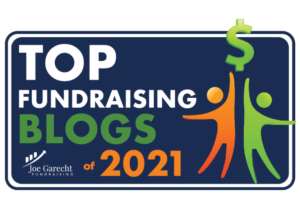Here’s a question I often get asked:
“What makes an effective fund development committee? What are ways people can contribute effectively even if they don’t have big money connections, etc.?”
Carter McNamara answered this really well earlier this year in his blog, but I’d like to add to his post. From Carter:
“One of the biggest misconceptions about the Fundraising Committee is that its members are to do the fundraising for the nonprofit. No, the job of the Fundraising Committee is to ensure that the fundraising is done very well. The actual fundraising should be done by all Board members, with various staff members supporting those Board members.”
I agree with Carter that the full board should be involved with the fund development process at an organization. Just a reminder though: Fund Development is, as defined by the Association of Fundraising Professionals: “The total process by which an organization increases public understanding of its mission and acquires financial support for its programs.”
In my fundraising action planning sessions we work to identify three or four strategic fundraising goals for the organization that include ways for the entire staff and board to participate in development. This is a key to success for any organization.
Simple ways for all staff and board to be involved can mean:
- Telling powerful compelling client stories
- Sharing the funding gap message with the community so people know what is needed (this is different from asking for money)
- Inviting guests e.g. donors or prospects to upcoming events
- Thanking recent donors via phone call and/or personal notes
- Or simply inviting guests (donors) to “business as usual” events like graduations or the school play or a volunteer training
In addition to my short list of development activities here are Carter’s six primary responsibilities for the fundraising or development committee:
1. Ensure there’s a specific fundraising target
How much money needs to be raised? Usually the amount is the difference between expected revenues and expenses. Usually those revenues and expenses are identified during strategic or program planning.
2. Ensure prospect research occurs to identify how much money might be raised from different types of resources
Good prospect research will look at the nature of the nonprofit’s services and its locale, and identify similar nonprofits and the sources of funding used by them. Good prospect research will go beyond searching a database of foundations to submit proposals to.
3. Identify specific, potential sources of funds from a diverse mix of sources
Now the nonprofit is ready to start selecting specific sources of funds from individuals, foundations, government and/or fees. These activities should result in the names of specific sources, for example, names of people, foundations and government agencies, and/or the specific amounts of fees to charge for certain services.
4. Develop an action plan about who is going to approach what source, how and by when*
This responsibility includes identifying which Board members will approach what source, along with what staff members will support those Board members. All Board members should have assignments, not just the members of the Fundraising Committee.
(*Note from Lori: This does not mean all board members must ask for money. It does mean board members can accompany staff on asks and share why they serve on the board and examples of client stories that may inspire the prospect.)
5. Compile the results of items 1- 4 into a Fundraising Plan that is approved by the Board
The Plan should include more than merely a listing of what foundations to approach. The Plan becomes the roadmap for generating sufficient revenue. It should include realistic expectations from a diversity of sources, and justify how those sources were identified. It should include an action plan (from step 4) that the Fundraising Committee ensures is implemented on a timely basis.
6. Ensure effective administrative systems to track grants and donations
As funding comes into the nonprofit, its various sources and amounts must be closely and accurately documented. Acknowledgements and receipts must be provided back to donors. Grant requirements must be monitored to ensure they are met. In the United States, fundraising information must be included on the IRS Form 990.
Summary — Job of the Fundraising Committee is to Ensure Planful, Strategic Fundraising.
This post was included in Withism’s from Lori: Boldness, Clarity & Wisdom for Fundraising Professionals Making a Difference (Volume 1), now available in paperback, on Kindle, and Nook.








Hi Lori,
This was always a frustration to me when I was a director of development or E.D. While the board needs to have oversight, too many of these committees are nothing but and end up being huge drains of time and energy without actually helping directly to fundraise. I’ve come to think that less is more when it comes to fund development committees. I’d put my efforts into a board solicitation committee to make sure the entire board is solicited for annual gifts in person, individually. And then, if there is enough volunteer involvement, an annual fund committee or corporate contributions committee to do likewise.
Great input, Brian. I like the idea of keeping the tasks very specific and something the board committee can do with ease and clear understanding. I bet you were an awesome Executive Director and Director of Development!
Great post, Lori. Your job summary is a resource that nonprofits can start using right away for their fund development committees, but also a model they can use to create job summaries for other committees. Can you imagine how efficiently the events committee or a gala committee or stewardship committee would run if they all detailed their roles and responsibilities?
As the Executive Director I, with a now retired Chairman of the Board, have been the major source of fundraising. We now have a “Development Associate” and a Development Committee of the Board. Who should the committee report to?
Hello Sallie,
Excellent question. There are a few parts to my answer.
1. The staff report to the board – to implement the fundraising plan that has been approved by the fundraising committee and staff.
2. The fundraising plan would be drafted by the staff, ideally you and the development associate. Here is a link to the free resources page on my website that has a framework for a fundraising plan. https://ignitedfundraising.com/training/free-resources/
I do help organizations draft these, but you can certainly draft one yourselves.
3. Once you’ve drafted your annual plan, bring it to the fundraising or development committee for discussion and approval. It’s important to identify which tasks the committee and full board can take on.
Special note: When drafting your plan pay special attention your strategic focus for retaining donors and increasing gift size.
4. With such a small fundraising staff, it’s ideal to have a volunteer fundraising team leader. This would be someone on your fundraising committee. This post may help identify the tasks for the team leader. Their focus is to help ensure stewardship tasks are being handled and not a burden for any single person: https://ignitedfundraising.com/assign-a-fundraising-leader-to-get-more-donations/
5. In my training sessions with board and staff I recommend 7 ways the board can support fund development, without having to ask for money. Here’s a link to a post with more info: https://ignitedfundraising.com/7-powerful-ways-board-members-can-help-not-ask-for-money/
Good luck and thanks for being a reader!